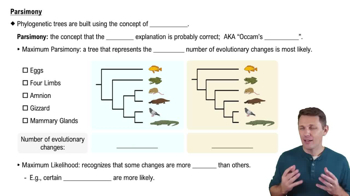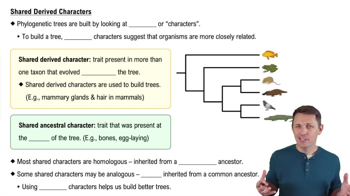Table of contents
- 1. Introduction to Biology2h 42m
- 2. Chemistry3h 40m
- 3. Water1h 26m
- 4. Biomolecules2h 23m
- 5. Cell Components2h 26m
- 6. The Membrane2h 31m
- 7. Energy and Metabolism2h 0m
- 8. Respiration2h 40m
- 9. Photosynthesis2h 49m
- 10. Cell Signaling59m
- 11. Cell Division2h 47m
- 12. Meiosis2h 0m
- 13. Mendelian Genetics4h 44m
- Introduction to Mendel's Experiments7m
- Genotype vs. Phenotype17m
- Punnett Squares13m
- Mendel's Experiments26m
- Mendel's Laws18m
- Monohybrid Crosses19m
- Test Crosses14m
- Dihybrid Crosses20m
- Punnett Square Probability26m
- Incomplete Dominance vs. Codominance20m
- Epistasis7m
- Non-Mendelian Genetics12m
- Pedigrees6m
- Autosomal Inheritance21m
- Sex-Linked Inheritance43m
- X-Inactivation9m
- 14. DNA Synthesis2h 27m
- 15. Gene Expression3h 20m
- 16. Regulation of Expression3h 31m
- Introduction to Regulation of Gene Expression13m
- Prokaryotic Gene Regulation via Operons27m
- The Lac Operon21m
- Glucose's Impact on Lac Operon25m
- The Trp Operon20m
- Review of the Lac Operon & Trp Operon11m
- Introduction to Eukaryotic Gene Regulation9m
- Eukaryotic Chromatin Modifications16m
- Eukaryotic Transcriptional Control22m
- Eukaryotic Post-Transcriptional Regulation28m
- Eukaryotic Post-Translational Regulation13m
- 17. Viruses37m
- 18. Biotechnology2h 58m
- 19. Genomics17m
- 20. Development1h 5m
- 21. Evolution3h 1m
- 22. Evolution of Populations3h 53m
- 23. Speciation1h 37m
- 24. History of Life on Earth2h 6m
- 25. Phylogeny2h 31m
- 26. Prokaryotes4h 59m
- 27. Protists1h 12m
- 28. Plants1h 22m
- 29. Fungi36m
- 30. Overview of Animals34m
- 31. Invertebrates1h 2m
- 32. Vertebrates50m
- 33. Plant Anatomy1h 3m
- 34. Vascular Plant Transport1h 2m
- 35. Soil37m
- 36. Plant Reproduction47m
- 37. Plant Sensation and Response1h 9m
- 38. Animal Form and Function1h 19m
- 39. Digestive System1h 10m
- 40. Circulatory System1h 49m
- 41. Immune System1h 12m
- 42. Osmoregulation and Excretion50m
- 43. Endocrine System1h 4m
- 44. Animal Reproduction1h 2m
- 45. Nervous System1h 55m
- 46. Sensory Systems46m
- 47. Muscle Systems23m
- 48. Ecology3h 11m
- Introduction to Ecology20m
- Biogeography14m
- Earth's Climate Patterns50m
- Introduction to Terrestrial Biomes10m
- Terrestrial Biomes: Near Equator13m
- Terrestrial Biomes: Temperate Regions10m
- Terrestrial Biomes: Northern Regions15m
- Introduction to Aquatic Biomes27m
- Freshwater Aquatic Biomes14m
- Marine Aquatic Biomes13m
- 49. Animal Behavior28m
- 50. Population Ecology3h 41m
- Introduction to Population Ecology28m
- Population Sampling Methods23m
- Life History12m
- Population Demography17m
- Factors Limiting Population Growth14m
- Introduction to Population Growth Models22m
- Linear Population Growth6m
- Exponential Population Growth29m
- Logistic Population Growth32m
- r/K Selection10m
- The Human Population22m
- 51. Community Ecology2h 46m
- Introduction to Community Ecology2m
- Introduction to Community Interactions9m
- Community Interactions: Competition (-/-)38m
- Community Interactions: Exploitation (+/-)23m
- Community Interactions: Mutualism (+/+) & Commensalism (+/0)9m
- Community Structure35m
- Community Dynamics26m
- Geographic Impact on Communities21m
- 52. Ecosystems2h 36m
- 53. Conservation Biology24m
25. Phylogeny
Phylogeny
Problem 2
Textbook Question
To apply parsimony to constructing a phylogenetic tree
a. Choose the tree that assumes all evolutionary changes are equally probable
b. Choose the tree in which the branch points are based on as many shared derived characters as possible
c. Choose the tree that represents the fewest evolutionary changes, in either DNA sequences or morphology
d. Choose the tree with the fewest branch points
 Verified step by step guidance
Verified step by step guidance1
Understand the concept of parsimony in phylogenetics: Parsimony is a principle that suggests the simplest explanation or path with the least number of steps is preferred. In the context of phylogenetic trees, it means choosing the tree that requires the fewest evolutionary changes.
Identify the key elements of the problem: The problem is asking which criterion should be used to apply parsimony when constructing a phylogenetic tree.
Analyze each option provided: a) assumes all changes are equally probable, b) focuses on shared derived characters, c) represents the fewest evolutionary changes, d) has the fewest branch points.
Relate the concept of parsimony to the options: Parsimony is directly related to minimizing evolutionary changes, which aligns with option c.
Conclude that the correct application of parsimony in constructing a phylogenetic tree is to choose the tree that represents the fewest evolutionary changes, as this aligns with the principle of simplicity and minimalism in evolutionary pathways.
 Verified video answer for a similar problem:
Verified video answer for a similar problem:This video solution was recommended by our tutors as helpful for the problem above
Video duration:
50sPlay a video:
Was this helpful?
Key Concepts
Here are the essential concepts you must grasp in order to answer the question correctly.
Parsimony in Phylogenetics
Parsimony, in the context of phylogenetics, is a principle that suggests the simplest explanation or path with the least number of changes is preferred. When constructing phylogenetic trees, parsimony aims to minimize the total number of evolutionary changes, such as mutations or trait modifications, required to explain the observed data. This approach helps in hypothesizing the most likely evolutionary relationships among species.
Recommended video:

Parsimony
Phylogenetic Tree
A phylogenetic tree is a diagram that represents the evolutionary relationships among various biological species based on similarities and differences in their physical or genetic characteristics. The tree's branches illustrate how species or other groups have diverged from common ancestors over time. Understanding the structure and interpretation of these trees is crucial for studying evolutionary biology and the history of life.
Recommended video:

Building Phylogenetic Trees Example 2
Shared Derived Characters
Shared derived characters, also known as synapomorphies, are traits that are present in an ancestral species and its descendants but absent in more distant relatives. These characters are crucial for determining evolutionary relationships because they provide evidence of common ancestry. In phylogenetic analysis, identifying shared derived characters helps in grouping species into clades, which are branches of the phylogenetic tree that include an ancestor and all its descendants.
Recommended video:

Shared Derived Characters

 7:10m
7:10mWatch next
Master Reading a Phylogenetic Tree with a bite sized video explanation from Jason
Start learningRelated Videos
Related Practice
Multiple Choice
Which statement below is true of parsimonious trees?
2284
views
